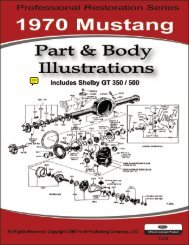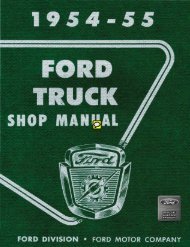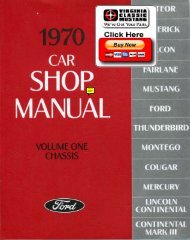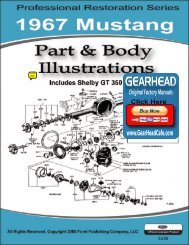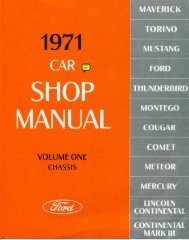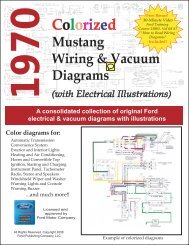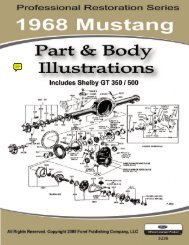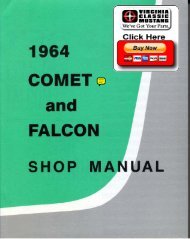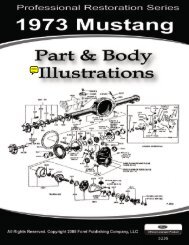DEMO - 1965 Ford Truck Shop Manual - ForelPublishing.com
DEMO - 1965 Ford Truck Shop Manual - ForelPublishing.com
DEMO - 1965 Ford Truck Shop Manual - ForelPublishing.com
Create successful ePaper yourself
Turn your PDF publications into a flip-book with our unique Google optimized e-Paper software.
2-84 GROUP 2-BRAKES<br />
1. Rest the push rod assembly upright<br />
on a flat surface, then position<br />
in order the seal spring, push rod<br />
seal, return spring, and non-pressure<br />
plate over the push rod.<br />
2. Force the non-pressure plate<br />
half of the chamber down against<br />
the spring until it rests on the flat<br />
surface. While holding the nonpressure<br />
plate against the tension of<br />
the return spring, clamp the push<br />
rod at the non-pressure plate with<br />
vise grip pliers or a similar tool<br />
(Fig. 21).<br />
3. With the push rod held secure<br />
to the non-pressure plate, place the<br />
clamp ring over the clamping surface<br />
of the non-pressure plate, aligning<br />
the marks made before disassembly.<br />
4. Position the diaphragm in the<br />
pressure plate half of the chamber<br />
and join with the open end of the<br />
non-pressure plate half, aligning the<br />
marks made during disassembly.<br />
While holding the two halves together,<br />
work the clamp ring over the<br />
clamping surface of the pressure<br />
plate half.<br />
5. Using a vise grip pliers or similar<br />
tool, clamp one set of clamp ring<br />
lugs and draw them together. AS-<br />
BRAKE<br />
ADJUSTING BOLT<br />
CHAMBER<br />
WEDGE<br />
ROLLERS<br />
BRAKE<br />
BRAKE<br />
FIG. 22-Stopmaster Brake Operation<br />
semble the bolt and nut in the other<br />
set of lugs and tighten. Remove the<br />
vise grip pliers and install the remaining<br />
bolt and nut. Tighten each<br />
clamp ring bolt and nut only enough<br />
to prevent leakage at the clamp ring<br />
surface.<br />
STOPMASTER BRAKE<br />
CHAMBER AND/OR<br />
DIAPHRAGM<br />
1. Disconnect the air lines from<br />
the brake chamber.<br />
2. Note the number of threads<br />
showing on the brake chamber tube<br />
so that it can be turned in the same<br />
distance upon installation. Loosen<br />
the spanner nut and lock washer on<br />
the tube, and unscrew the <strong>com</strong>plete<br />
brake chamber from the actuator<br />
housing (Fig. 22).<br />
3. Remove the two bolts and nuts<br />
from the clamping ring to separate<br />
the pressure housing and diaphragm<br />
from the non-pressure housing.<br />
4. Install the new diaphragm<br />
against the head of the diaphragm<br />
plate (Fig. 23). Secure the pressure<br />
housing to the non-pressure housing<br />
with the clamp ring and the two<br />
clamp ring bolts and nuts.<br />
SHOE<br />
SHOE<br />
ACTUATOR<br />
HOUSING<br />
ADJUSTING<br />
RETRACTING<br />
HOLD-DOWN<br />
BOLT<br />
SPRING<br />
SPRING<br />
H1257-A<br />
5. Screw the brake chamber into<br />
the actuator housing up to the mark<br />
made on the threads at removal.<br />
Tighten the spanner nut.<br />
6. Connect the air lines to the<br />
brake chamber.<br />
STOPMASTER BRAKE<br />
ACTUATING SYSTEM<br />
DISASSEMBLY<br />
1. Remove the wheel hub and<br />
drum assembly, and the brake shoes.<br />
2. Exhaust the air from the<br />
system and disconnect the air lines<br />
from the air chamber housings.<br />
3. Loosen the spanner nut and<br />
lock washer on each brake chamber<br />
tube, and unscrew the brake chambers<br />
from their actuator housings<br />
(Fig. 22).<br />
4. At each actuator housing, remove<br />
the wedge, roller, and spring<br />
assembly by pulling it straight out<br />
of the housing (Fig. 23).<br />
5. Remove the plunger guide cap<br />
screws, then pull both plungers out<br />
of each housing.<br />
6. On front brakes, the actuation<br />
housings can be removed by taking<br />
out four mounting bolts. On rear<br />
brakes, the housings are integral with<br />
the spider. If a rear brake actuator<br />
housing needs replacement, remove<br />
the entire spider.<br />
7. Clean and inspect all <strong>com</strong>ponents.<br />
Replace all parts that are<br />
worn, bent or damaged. Coat all parts<br />
with M1C-69-A grease or equivalent<br />
before assembly.<br />
ASSEMBLY<br />
1. On front brakes, install the actuator<br />
housings to the spider, and secure<br />
each housing with four mounting<br />
bolts. If the brake spider and<br />
housing assembly was removed from<br />
a rear brake, install a new assembly<br />
to the carrier plate.<br />
2. Install the plungers in their actuator<br />
housings in such a way that<br />
the guide slots face away from the<br />
spider to receive the plunger guide<br />
cap screws. Note the relative posi-




